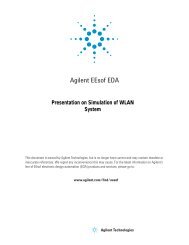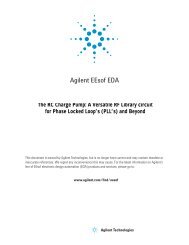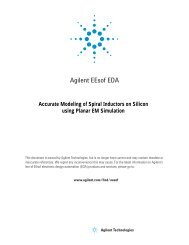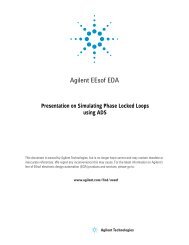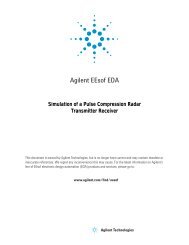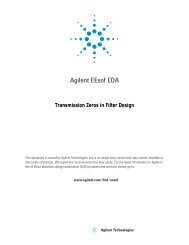Presentation on Digital Predistortion of Power Amplifiers - Agilent ...
Presentation on Digital Predistortion of Power Amplifiers - Agilent ...
Presentation on Digital Predistortion of Power Amplifiers - Agilent ...
You also want an ePaper? Increase the reach of your titles
YUMPU automatically turns print PDFs into web optimized ePapers that Google loves.
<strong>Agilent</strong> EEs<strong>of</strong> EDA<br />
This document is owned by <strong>Agilent</strong> Technologies, but is no l<strong>on</strong>ger kept current and may c<strong>on</strong>tain obsolete or<br />
inaccurate references. We regret any inc<strong>on</strong>venience this may cause. For the latest informati<strong>on</strong> <strong>on</strong> <strong>Agilent</strong>’s<br />
line <strong>of</strong> EEs<strong>of</strong> electr<strong>on</strong>ic design automati<strong>on</strong> (EDA) products and services, please go to:<br />
www.agilent.com/find/ees<strong>of</strong>
<strong>Digital</strong> Predistorti<strong>on</strong> - 1<br />
Module 1:<br />
<strong>Digital</strong> Predistorti<strong>on</strong> <strong>of</strong> <strong>Power</strong><br />
<strong>Amplifiers</strong><br />
Active linearizati<strong>on</strong> has become an important technology in modern communicati<strong>on</strong>s systems. The<br />
emphasizes <strong>on</strong> higher data rates and spectral efficiency has driven the industry towards linear<br />
modulati<strong>on</strong> techniques such as QPSK, 64 QAM, or multicarrier c<strong>on</strong>figurati<strong>on</strong>s. The result is a signal<br />
with a fluctuating envelope which generates intermodulati<strong>on</strong> (IM) distorti<strong>on</strong> from the power<br />
amplifiers. Since most <strong>of</strong> the IM power appears as interference in adjacent channels, it is important to<br />
use a highly linear power amplifier. Linearizati<strong>on</strong> <strong>of</strong> a power-efficient amplifier is a desirable<br />
alternative to backing-<strong>of</strong>f a Class A amplifier which would result in low power efficiency as well as<br />
c<strong>on</strong>siderable heat dissipati<strong>on</strong>. A digital baseband predistorter has the distinct advantage <strong>of</strong> being<br />
capable <strong>of</strong> handling rapid fluctuati<strong>on</strong>s in amplifier characteristics, however it typically operates <strong>on</strong><br />
low bandwidth signals. This predistorti<strong>on</strong> technique can functi<strong>on</strong> independently from the modulati<strong>on</strong><br />
scheme.<br />
Shawn P. Staplet<strong>on</strong><br />
in cooperati<strong>on</strong> with:<br />
<strong>Agilent</strong> Technologies, Inc.<br />
<strong>Agilent</strong> EEs<strong>of</strong> EDA<br />
1400 Fountaingrove Parkway<br />
Santa Rosa, CA 95403-1799
About the Author<br />
Shawn P. Staplet<strong>on</strong><br />
• Pr<strong>of</strong>essor: Sim<strong>on</strong> Fraser University<br />
• Focus <strong>on</strong> integrated RF/DSP applicati<strong>on</strong>s<br />
• PhD, 1988, Carlet<strong>on</strong> University, Canada<br />
• RF/Microwave communicati<strong>on</strong>s systems<br />
• Expert in Adaptive Linearizati<strong>on</strong> techniques<br />
<strong>Digital</strong> Predistorti<strong>on</strong> <strong>of</strong> <strong>Power</strong> Amps<br />
June, 01<br />
Page 2<br />
Shawn P. Staplet<strong>on</strong> is a Pr<strong>of</strong>essor at Sim<strong>on</strong> Fraser University. He research focuses <strong>on</strong><br />
integrated RF/DSP applicati<strong>on</strong>s for Wireless Communicati<strong>on</strong>s. He received his BEng in 1982,<br />
MEng in 1984 and PhD in 1988 from Carlet<strong>on</strong> University, Canada, where his studies were<br />
focused <strong>on</strong> RF/Microwave Communicati<strong>on</strong>s. Before joining Sim<strong>on</strong> Fraser University, Shawn<br />
worked <strong>on</strong> a wide variety <strong>of</strong> projects including: multi-rate digital signal processing,<br />
RF/Microwave communicati<strong>on</strong>s systems, and Adaptive Array Antennas. While at Sim<strong>on</strong><br />
Fraser University he developed a number <strong>of</strong> Adaptive Linearizati<strong>on</strong> techniques ranging from<br />
Feedforward, Active Biasing, Work Functi<strong>on</strong> Predistorti<strong>on</strong> to <strong>Digital</strong> Baseband Predistorters.<br />
He has published numerous technical papers <strong>on</strong> Linearizati<strong>on</strong> and has given many<br />
presentati<strong>on</strong>s at various companies <strong>on</strong> the subject. He c<strong>on</strong>tinues to research the field <strong>of</strong><br />
utilizing DSP techniques to produce <strong>Power</strong> Efficient <strong>Amplifiers</strong> for Mobile Communicati<strong>on</strong>s<br />
applicati<strong>on</strong>s..<br />
Shawn P. Staplet<strong>on</strong> is a registered Pr<strong>of</strong>essi<strong>on</strong>al Engineer in the province <strong>of</strong> British Columbia.<br />
<strong>Digital</strong> Predistorti<strong>on</strong> - 2
Agenda & Topics<br />
<strong>Digital</strong> Predistorti<strong>on</strong> <strong>of</strong> <strong>Power</strong> <strong>Amplifiers</strong><br />
• Introducti<strong>on</strong> to Adaptive <strong>Digital</strong> Predistorti<strong>on</strong><br />
• Technology Overview <strong>of</strong> Linearizati<strong>on</strong><br />
• Key Features: <strong>Digital</strong> Predistorti<strong>on</strong> Techniques & C<strong>on</strong>cepts<br />
• Adaptati<strong>on</strong> Techniques<br />
• <strong>Digital</strong> Predistorti<strong>on</strong> Design Tools<br />
• C<strong>on</strong>clusi<strong>on</strong><br />
<strong>Digital</strong> Predistorti<strong>on</strong> <strong>of</strong> <strong>Power</strong> Amps<br />
June, 01<br />
Page 3<br />
You will receive an introducti<strong>on</strong> and basic overview <strong>of</strong> the key features, technologies, and<br />
performance requirements <strong>of</strong> Predistorti<strong>on</strong> in this paper. Soluti<strong>on</strong>s for solving some <strong>of</strong> the<br />
design challenges will also be presented. An adaptive digital baseband predistorter is<br />
dem<strong>on</strong>strated using the ADS. More in depth analysis can be obtained in the references at<br />
the end <strong>of</strong> this technical informati<strong>on</strong> sessi<strong>on</strong>.<br />
<strong>Digital</strong> Predistorti<strong>on</strong> - 3
<strong>Digital</strong> Predistorti<strong>on</strong> - 4<br />
Introducti<strong>on</strong><br />
• <strong>Power</strong> Amplifier Intermodulati<strong>on</strong> distorti<strong>on</strong><br />
– due to fluctuating envelope: QPSK, 64 QAM, etc.<br />
• Two methods <strong>of</strong> achieving linear amplificati<strong>on</strong>:<br />
– Back-<strong>of</strong>f the Class A amplifier - this reduces the power<br />
efficiency and increases the heat dissipati<strong>on</strong>.<br />
– Linearize a power-efficient amplifier using external circuitry.<br />
• Adaptati<strong>on</strong> is required to compensate for comp<strong>on</strong>ent tolerances,<br />
drift, and input power level variati<strong>on</strong>s.<br />
<strong>Digital</strong> Predistorti<strong>on</strong> <strong>of</strong> <strong>Power</strong> Amps<br />
June, 01<br />
Page 4<br />
Increasing demand for spectral efficiency in radio communicati<strong>on</strong>s makes multilevel<br />
linear modulati<strong>on</strong> schemes such as Quadrature Amplitude Modulati<strong>on</strong> more and more<br />
attractive. Since their envelopes fluctuate, these schemes are more sensitive to the power<br />
amplifier n<strong>on</strong>linearities which is the major c<strong>on</strong>tributor <strong>of</strong> n<strong>on</strong>linear distorti<strong>on</strong> in a<br />
microwave transmitter. An obvious soluti<strong>on</strong> is to operate the power amplifier in the linear<br />
regi<strong>on</strong> where the average output power is much smaller than the amplifier’s saturati<strong>on</strong><br />
power (ie. Larger output back-<strong>of</strong>f). But this increases both cost and inefficiency as more<br />
stages are required in the amplifier to maintain a given level <strong>of</strong> power transmitted and<br />
hence greater DC power is c<strong>on</strong>sumed. <strong>Power</strong> efficiency is certainly a critical<br />
c<strong>on</strong>siderati<strong>on</strong> in portable systems where batteries are <strong>of</strong>ten used or in small enclosures<br />
where heat dissipati<strong>on</strong> is a problem. Another approach to reducing n<strong>on</strong>linear distorti<strong>on</strong> is<br />
the linearizati<strong>on</strong> <strong>of</strong> the power amplifier.<br />
The power amplifier’s characteristics tend to drift with time, due to temperature changes,<br />
voltage variati<strong>on</strong>s, channel changes, aging, etc. Therefore a robust linearizer should<br />
incorporate some form <strong>of</strong> adaptati<strong>on</strong>.
<strong>Digital</strong> Predistorti<strong>on</strong> - 5<br />
<strong>Power</strong> Amplifier Characteristics<br />
(W)<br />
(Normalized to Psat)<br />
(W)<br />
(Normalized to Psat)<br />
Measured Characteristics <strong>of</strong> a Typical Class AB <strong>Power</strong> Amplifier<br />
<strong>Digital</strong> Predistorti<strong>on</strong> <strong>of</strong> <strong>Power</strong> Amps<br />
June, 01<br />
Page 5<br />
N<strong>on</strong>linear amplifiers are characterized by measurement <strong>of</strong> their AM/AM (amplitude<br />
dependent gain) and AM/PM (amplitude dependent phase shift) characteristics. Not <strong>on</strong>ly<br />
are RF amplifiers n<strong>on</strong>linear, but they also possess memory: the output signal depends <strong>on</strong><br />
the current value <strong>of</strong> the input signal as well as previous values spanning the memory <strong>of</strong><br />
the amplifier. Class AB power amplifiers (~25% efficient) are more power efficient than<br />
Class A amplifiers (~5% efficient) . Class AB amplifiers exhibit gain roll-<strong>of</strong>f at low input<br />
powers as well as at saturati<strong>on</strong>. The loss <strong>of</strong> gain at low levels is due to the crossover<br />
regi<strong>on</strong> created by the push/pull transistor c<strong>on</strong>figurati<strong>on</strong>.
<strong>Digital</strong> Predistorti<strong>on</strong> - 6<br />
<strong>Power</strong> Amplifier Spectral Output<br />
(10KHz/Div)<br />
<strong>Power</strong> Spectra: Class AB <strong>Power</strong> Amplifier with π/4 /4 DQPSK modulati<strong>on</strong><br />
<strong>Digital</strong> Predistorti<strong>on</strong> <strong>of</strong> <strong>Power</strong> Amps<br />
June, 01<br />
Page 6<br />
Regulatory bodies specify power spectral density masks which define the maximum<br />
allowable adjacent channel interference (ACI) levels. TETRA, for example, uses a π/4<br />
DQPSK modulati<strong>on</strong> format with a symbol rate <strong>of</strong> 18 KHz; channel spacing is 25 KHz. The<br />
Class AB power amplifier is operating at a back-<strong>of</strong>f power <strong>of</strong> 3dB. In order to meet the<br />
regulatory mask, at least a 20 dB improvement in the intermodulati<strong>on</strong> products is<br />
required.
<strong>Digital</strong> Predistorti<strong>on</strong> - 7<br />
Technology Overview<br />
Linearizati<strong>on</strong> approaches:<br />
• FeedForward Linearizati<strong>on</strong><br />
• Based <strong>on</strong> inherently wideband technology<br />
• RF Predistorti<strong>on</strong><br />
• Limited accuracy <strong>of</strong> functi<strong>on</strong> model<br />
• Implemented at RF with low complexity<br />
• Cartesian Feedback<br />
• Stability c<strong>on</strong>siderati<strong>on</strong>s limit bandwidth and accuracy<br />
• LINC<br />
• Sensitive to comp<strong>on</strong>ent drift and has a high level <strong>of</strong> complexity<br />
• Dynamic Biasing<br />
• Limited ACI suppressi<strong>on</strong><br />
• <strong>Digital</strong> Predistorti<strong>on</strong><br />
• Limited Bandwidth (DSP implementati<strong>on</strong>)<br />
• Good IMD suppressi<strong>on</strong><br />
<strong>Digital</strong> Predistorti<strong>on</strong> <strong>of</strong> <strong>Power</strong> Amps<br />
June, 01<br />
Page 7<br />
Several linearizati<strong>on</strong> techniques have been developed. Predistorti<strong>on</strong> is the most<br />
comm<strong>on</strong>ly used technique, the c<strong>on</strong>cept is to insert a n<strong>on</strong>linear module between the input<br />
signal and the power amplifier. The n<strong>on</strong>linear module generates IMD products that are in<br />
anti-phase with the IMD products produced by the power amplifier, reducing the out-<strong>of</strong>band<br />
emissi<strong>on</strong>s. The RF based predistorter has two distinct advantages: 1) the correcti<strong>on</strong><br />
is applied before the power amplifier where inserti<strong>on</strong> loss is not as critical 2) the<br />
correcti<strong>on</strong> architecture has a moderate bandwidth. Cartesian feedback , has relatively low<br />
complexity, <strong>of</strong>fers reas<strong>on</strong>able IMD suppressi<strong>on</strong>, but stability c<strong>on</strong>siderati<strong>on</strong>s limit the<br />
bandwidth to a few hundred KHz.The LINC technique c<strong>on</strong>verts the input signal into two<br />
c<strong>on</strong>stant envelope signals that are amplified by Class C amplifiers and then combined<br />
before transmissi<strong>on</strong>. C<strong>on</strong>sequently, they are very sensitive to comp<strong>on</strong>ent drift. Dynamic<br />
biasing is similar to predistorti<strong>on</strong>, however, the work functi<strong>on</strong> operates <strong>on</strong> the <strong>Power</strong><br />
Amplifier’s operating bias. This technique creates transient spikes from the effects <strong>of</strong><br />
rapid bias switching. Feedforward linearizati<strong>on</strong> is the <strong>on</strong>ly strategy that simultaneously<br />
<strong>of</strong>fers wide bandwidth and good IMD suppressi<strong>on</strong>: the price for this performance is the<br />
higher complexity. Automatic adaptati<strong>on</strong> is essential to maintain performance. The digital<br />
predistorti<strong>on</strong> technique [1-9] has a higher complexity but <strong>of</strong>fers better IMD suppressi<strong>on</strong>.<br />
However, bandwidths are low due to limited DSP computati<strong>on</strong>al rates. <strong>Digital</strong><br />
predistorti<strong>on</strong> is typically implemented at baseband using either a DSP chip, a Field<br />
Programmable Gate Array or an ASIC.
<strong>Digital</strong> Predistorti<strong>on</strong> - 8<br />
<strong>Digital</strong> Predistorti<strong>on</strong><br />
<strong>Digital</strong> Domain<br />
Analog Domain<br />
Data<br />
Modem<br />
Complex Gain<br />
Predistorter<br />
D<br />
A<br />
C<br />
Quadrature<br />
Modulator<br />
<strong>Power</strong><br />
Amplifier<br />
Adaptati<strong>on</strong><br />
A<br />
D<br />
C<br />
Quadrature<br />
Demodulator<br />
Local<br />
Oscillator<br />
<strong>Digital</strong> Predistorti<strong>on</strong> <strong>of</strong> <strong>Power</strong> Amps<br />
June, 01<br />
FeedForward Linearizati<strong>on</strong><br />
Page 8<br />
This slide illustrates the s<strong>of</strong>tware/hardware boundary for the adaptive linearizati<strong>on</strong> circuit.<br />
In additi<strong>on</strong> to a <strong>Power</strong> Amplifier, it also requires a coupler, quadrature modulator and<br />
demodulator as well as an A/D and D/A c<strong>on</strong>verter. Note that the same oscillator is used in<br />
the Up and Down c<strong>on</strong>versi<strong>on</strong> for coherence, some methods require a phase shifter for<br />
achieving stability. The linearizer creates a predistorted versi<strong>on</strong> <strong>of</strong> the desired modulati<strong>on</strong>.<br />
The predistorter c<strong>on</strong>sists <strong>of</strong> a complex gain adjuster which c<strong>on</strong>trols the amplitude and<br />
phase <strong>of</strong> the input signal. The amount <strong>of</strong> predistorti<strong>on</strong> is c<strong>on</strong>trolled by the entries <strong>of</strong> a<br />
Look-up Table that interpolate the AM/AM and AM/PM n<strong>on</strong>linearities <strong>of</strong> the power<br />
amplifier. Note that the envelope <strong>of</strong> the input signal is an input to the Look-up table. The<br />
feedback path samples the distorted signal for which the DSP adjusts the Look-up Table<br />
entries so as to minimize the level <strong>of</strong> distorti<strong>on</strong>.
<strong>Digital</strong> Predistorti<strong>on</strong> - 9<br />
Spectrum at the Nodes<br />
<strong>Digital</strong> Domain<br />
Analog Domain<br />
Data<br />
Modem<br />
Complex Gain<br />
Predistorter<br />
D<br />
A<br />
C<br />
Quadrature<br />
Modulator<br />
<strong>Power</strong><br />
Amplifier<br />
Local<br />
Oscillator<br />
Adaptati<strong>on</strong><br />
A<br />
D<br />
C<br />
Quadrature<br />
Demodulator<br />
<strong>Digital</strong> Predistorti<strong>on</strong> <strong>of</strong> <strong>Power</strong> Amps<br />
June, 01<br />
FeedForward Linearizati<strong>on</strong><br />
Page 9<br />
We can observe the spectral resp<strong>on</strong>se at various nodes in the digital baseband<br />
predistorter given a two t<strong>on</strong>e input signal. The functi<strong>on</strong> <strong>of</strong> the adaptati<strong>on</strong> block is to<br />
extract the amplitude modulati<strong>on</strong> <strong>of</strong> the input RF signal and adjust the Look-up Table<br />
entries. The entries <strong>of</strong> the Look-up Table will be indexed by the level <strong>of</strong> the input signal<br />
envelope. The complex gain adjuster, <strong>on</strong>ce optimized, will provide the inverse n<strong>on</strong>linear<br />
characteristics to that <strong>of</strong> the power amplifier. Thus <strong>on</strong>e can observe at the input mode to<br />
the power amplifier, the spectral growth from the predistorter. Ideally the<br />
intermodulati<strong>on</strong> products will be <strong>of</strong> equal amplitude but in anti-phase to those created as<br />
the two t<strong>on</strong>es pass through the power amplifier. The functi<strong>on</strong> <strong>of</strong> the DSP adaptati<strong>on</strong> block<br />
is to adjust the Look-up Table entries so as to minimize the difference between the input<br />
signal and a scaled versi<strong>on</strong> <strong>of</strong> the output signal from the power amplifier. Thereby<br />
minimizing the level <strong>of</strong> distorti<strong>on</strong>.
Design Techniques<br />
<strong>Digital</strong> Predistorti<strong>on</strong><br />
• Generic digital predistorti<strong>on</strong> techniques<br />
– complex vector mapping look-up table<br />
– complex gain look-up table<br />
– cartesian feedback<br />
• Generic adaptati<strong>on</strong> techniques...<br />
– Secant method<br />
– linear c<strong>on</strong>vergence<br />
<strong>Digital</strong> Predistorti<strong>on</strong> <strong>of</strong> <strong>Power</strong> Amps<br />
June, 01<br />
Page 10<br />
There are three generic digital predistorters. The cartesian feedback linearizer is the most<br />
simplistic <strong>of</strong> the techniques and is based <strong>on</strong> the classical feedback c<strong>on</strong>trol system. The power<br />
amplifier’s input is proporti<strong>on</strong>al to the error that results from the subtracti<strong>on</strong> <strong>of</strong> the undistorted<br />
input signal from that <strong>of</strong> the power amplifier output. The drawbacks to this technique are the<br />
linearity and bandwidth dependence <strong>on</strong> the feedback time delay as well as the potential instability.<br />
Another technique is the complex vector mapping look-up table (LUT) approach, in which the<br />
output vector <strong>of</strong> the LUT is a predistorted versi<strong>on</strong> <strong>of</strong> the input vector. The drawback to this<br />
technique is the stability requirement for an accurate adjustment <strong>of</strong> the phase shifter in the<br />
feedback path. The complex gain LUT technique eliminates the need for a phase shifter. This<br />
approach uses the envelope <strong>of</strong> the input signal as the index to the LUT entries. The input signal is<br />
then multiplied by the table LUT values which are the predistorter’s complex gains.<br />
There are various adaptati<strong>on</strong> techniques available, two <strong>of</strong> the most comm<strong>on</strong> approaches are the<br />
secant method and the linear c<strong>on</strong>vergence method. The secant method requires the formulati<strong>on</strong><br />
<strong>of</strong> the adaptati<strong>on</strong> into a root finding problem. The root is the error resulting from the difference<br />
between the input and a scaled versi<strong>on</strong> <strong>of</strong> the output. The root is a functi<strong>on</strong> <strong>of</strong> the table entries<br />
which are adjusted using the classical secant method [4]. The linear c<strong>on</strong>vergence method is a<br />
slower method but is simpler to implement. This approach uses a scaled versi<strong>on</strong> <strong>of</strong> the resulting<br />
error signal to adjust the LUT entries iteratively . The scaling parameter c<strong>on</strong>trols the rate <strong>of</strong><br />
c<strong>on</strong>vergence.<br />
<strong>Digital</strong> Predistorti<strong>on</strong> - 10
The cartesian feedback technique [1] has the virtue <strong>of</strong> simplicity; the amplifier input complex<br />
envelope is proporti<strong>on</strong>al to the difference between the desired and measured amplifier output. This<br />
negative feedback technique is c<strong>on</strong>strained in the amount <strong>of</strong> reducti<strong>on</strong> in distorti<strong>on</strong> achievable. Both<br />
the linearity as well as the bandwidth are critically dependent <strong>on</strong> the feedback loop delay. The<br />
negative feedback gain adjusts the level <strong>of</strong> n<strong>on</strong>linear distorti<strong>on</strong>. Another issue is that <strong>of</strong> stability,<br />
where precise adjustment is required <strong>of</strong> the RF phase shifter.<br />
<strong>Digital</strong> Predistorti<strong>on</strong> - 11
<strong>Digital</strong> Predistorti<strong>on</strong> - 12<br />
Complex Vector Mapping LUT<br />
<strong>Digital</strong> Domain<br />
Analog Domain<br />
Data<br />
Modulating<br />
Signal<br />
Generator<br />
V m<br />
(t)<br />
V d<br />
(t)<br />
D<br />
A<br />
C<br />
Quadrature<br />
Modulator<br />
<strong>Power</strong><br />
Amplifier<br />
RAM<br />
Look-up<br />
Table<br />
V c<br />
(t)<br />
Local<br />
Oscillator<br />
Delay<br />
1/a<br />
phase<br />
shift<br />
V e<br />
(t)<br />
A<br />
D<br />
C<br />
Quadrature<br />
Demodulator<br />
Delay Adjust<br />
V a<br />
(t)<br />
<strong>Digital</strong> Predistorti<strong>on</strong> <strong>of</strong> <strong>Power</strong> Amps<br />
June, 01<br />
Page 12<br />
The complex vector mapping LUT [6] approach compares the measured signal Va(t) with the<br />
reference signal Vm(t), the resultant error signal is used to update the RAM Look-Up Table.<br />
There exists some delay in the feedback path that needs to be compensated for by delaying the<br />
reference signal before a comparis<strong>on</strong> is made. The delay adjusting circuit can use the modulati<strong>on</strong><br />
characteristics to c<strong>on</strong>tinuously track the delay . Typically is the delay is c<strong>on</strong>trolled to within 1/64<br />
th <strong>of</strong> a symbol durati<strong>on</strong> this will keep sufficient linearizati<strong>on</strong>. This technique also requires a phase<br />
shifter in the feedback path for stability in the adaptati<strong>on</strong> update and tends to slow the<br />
c<strong>on</strong>vergence time. This particular c<strong>on</strong>figurati<strong>on</strong> uses the linear c<strong>on</strong>vergence approach where “a”<br />
is the updating gain parameter. The compensating vectors Vc(t) are stored in the RAM look-up<br />
table and indexed by the instantaneous input vectors. Thus the requirement for a large random<br />
access memory for storing all the possible input vector states. Typically a 10 bit A/D and D/A is<br />
sufficient for achieving -60 dBc intermodulati<strong>on</strong> levels.
The complex gain Look-up Table technique [4] adapts the table entries to achieve the inverse<br />
AM/AM and AM/PM characteristics from that <strong>of</strong> the power amplifier. The LUT is indexed by the<br />
instantaneous amplitude <strong>of</strong> the input signal. If the power amplifier n<strong>on</strong>linearity is well behaved at<br />
lower power levels then the LUT can be indexed by the square <strong>of</strong> the input amplitude. In this case as<br />
little as 64 table entries have been dem<strong>on</strong>strated to provide sufficient spectral c<strong>on</strong>trol. A particular<br />
advantage <strong>of</strong> this approach is that the complex gain functi<strong>on</strong> can adapt very quickly to channel<br />
changes because <strong>of</strong> the reduced number <strong>of</strong> LUT entries that need to be adjusted.<br />
<strong>Digital</strong> Predistorti<strong>on</strong> - 13
The complex gain functi<strong>on</strong> F{x} is indexed by the instantaneous input amplitude. The LUT entry for<br />
the corresp<strong>on</strong>ding input vector’s amplitude is then multiplied by the input signal vector. The updates<br />
to the predistorter LUT are c<strong>on</strong>tinually adjusted by comparing the reference complex envelope Vm(t)<br />
with the sampled feedback modulati<strong>on</strong> Va(t). The resultant loop error vector is then separated into a<br />
scaling and rotati<strong>on</strong> error comp<strong>on</strong>ent. For all inputs to the amplifier <strong>of</strong> identical instantaneous signal<br />
amplitude, the scaling and rotati<strong>on</strong> errors will be identical.<br />
<strong>Digital</strong> Predistorti<strong>on</strong> - 14
Linear C<strong>on</strong>vergence<br />
Input<br />
Input<br />
| |<br />
A<br />
D<br />
C<br />
i<br />
LUT<br />
LUT<br />
S(i,n)<br />
R(i,n)<br />
r<br />
O<br />
Polar<br />
to<br />
Rect.<br />
Q<br />
I<br />
complex<br />
gain<br />
adjuster<br />
output output to to PA<br />
PA<br />
-0.1<br />
S(i,n+1) = S(i,n) - 0.1* |Ve|<br />
Ve|<br />
R(i,n+1) = R(i,n) - 0.1* ∠Ve<br />
S(i,n+1)<br />
R(i,n+1)<br />
LUT<br />
LUT<br />
O<br />
I<br />
Polar<br />
to<br />
Rect.<br />
V e<br />
r<br />
Q<br />
Error Error Vector<br />
Vector<br />
<strong>Digital</strong> Predistorti<strong>on</strong> <strong>of</strong> <strong>Power</strong> Amps<br />
June, 01<br />
Page 15<br />
S and R represent the scaling and rotati<strong>on</strong> errors which are stored in the LUT [5] and are indexed<br />
by the instantaneous input amplitude. Using linear c<strong>on</strong>vergence with an update gain parameter<br />
equal to -0.1, the new LUT entry will replace the previous value according to the scaling and<br />
rotati<strong>on</strong>al error. This approach requires the use <strong>of</strong> both a polar to rectangular transformati<strong>on</strong> as<br />
well as a rectangular to polar transformati<strong>on</strong>.<br />
<strong>Digital</strong> Predistorti<strong>on</strong> - 15
<strong>Digital</strong> Predistorti<strong>on</strong> - 16<br />
ADS RF Predistorti<strong>on</strong> Simulati<strong>on</strong><br />
Simulati<strong>on</strong> Parameters:<br />
1) Multi-t<strong>on</strong>e Modulati<strong>on</strong> (Fc(<br />
Fc=800<br />
MHz, BW=25 MHz)<br />
2) 64 entry look-up table<br />
3) Complex gain look-up table technique<br />
4) linear c<strong>on</strong>vergence parameter is -0.1<br />
5) Behavioral model for <strong>Power</strong> Amplifier<br />
6) Ideal passive comp<strong>on</strong>ents assumed<br />
<strong>Digital</strong> Predistorti<strong>on</strong> <strong>of</strong> <strong>Power</strong> Amps<br />
June, 01<br />
Page 16<br />
The ADS digital baseband predistorter simulati<strong>on</strong> example is based <strong>on</strong> the complex gain look-up<br />
table technique. Where we utilize the linear c<strong>on</strong>vergence method to adapt the LUT entries so as to<br />
minimize the level <strong>of</strong> undesired distorti<strong>on</strong>. The LUT c<strong>on</strong>sists <strong>of</strong> <strong>on</strong>ly 64 entries which are indexed<br />
by a 6 bit A/D c<strong>on</strong>verter. The power amplifier used in this example has a behavioural model. We<br />
have assumed the passive comp<strong>on</strong>ents, such as the power splitters and combiners are ideal.<br />
For dem<strong>on</strong>strati<strong>on</strong> purposes we have used a multi-t<strong>on</strong>e input centered <strong>on</strong> 800 MHz. The<br />
bandwidth has been exaggerated to dem<strong>on</strong>strate the adaptati<strong>on</strong> requirements for wide<br />
bandwidths.
ADS Simulati<strong>on</strong> Setup<br />
Data Flow C<strong>on</strong>troller and Variables<br />
that will be used in the Simulati<strong>on</strong>:<br />
<strong>Digital</strong> Predistorti<strong>on</strong> <strong>of</strong> <strong>Power</strong> Amps<br />
June, 01<br />
FeedForward Linearizati<strong>on</strong><br />
Page 17<br />
<strong>Agilent</strong> Ptolemy simulati<strong>on</strong> c<strong>on</strong>troller and the variable equati<strong>on</strong> block for defining the<br />
<strong>Digital</strong> Baseband Predistorter parameters.<br />
Time_Step is the simulati<strong>on</strong> step time in microsec<strong>on</strong>ds.<br />
Freq_Center is the center frequency in MHz .<br />
Delta is <strong>on</strong>e half the frequency separati<strong>on</strong> between t<strong>on</strong>es.<br />
<strong>Digital</strong> Predistorti<strong>on</strong> - 17
<strong>Digital</strong> Predistorti<strong>on</strong> - 18<br />
ADS <strong>Digital</strong> Predistorti<strong>on</strong> Circuit<br />
LUT LUT Clock Clock Timing<br />
Timing<br />
Output<br />
Output<br />
Input<br />
Input<br />
<strong>Digital</strong> Predistorti<strong>on</strong> <strong>of</strong> <strong>Power</strong> Amps<br />
June, 01<br />
Page 18<br />
The ADS circuit schematic for the digital baseband predistorter . The adaptati<strong>on</strong> technique is<br />
based <strong>on</strong> the linear c<strong>on</strong>vergence method. The rectangular implementati<strong>on</strong> is used for the<br />
complex gain adjuster. The input c<strong>on</strong>sists <strong>of</strong> a multi-t<strong>on</strong>e modulati<strong>on</strong>. The timing clocks used<br />
for the DSP c<strong>on</strong>trol is located up top. A behavioural model is used for the power amplifier.
Input <strong>of</strong> <strong>Digital</strong> Predistorter Circuit<br />
Ten Ten T<strong>on</strong>e T<strong>on</strong>e Input<br />
Input<br />
(2.5 (2.5 MHz MHz spacings)<br />
spacings)<br />
<strong>Digital</strong> Predistorti<strong>on</strong> <strong>of</strong> <strong>Power</strong> Amps<br />
June, 01<br />
Page 19<br />
Focusing <strong>on</strong> the input. A ten t<strong>on</strong>e input signal with frequency spacing <strong>of</strong> 2.5 MHz is used. The<br />
signal sources are 5 equal power quadrature modulators that independently generate two<br />
t<strong>on</strong>es.<br />
<strong>Digital</strong> Predistorti<strong>on</strong> - 19
<strong>Digital</strong> Predistorti<strong>on</strong> - 20<br />
Complex Gain Adjuster <strong>of</strong> Predistorter<br />
In-phase<br />
In-phase<br />
<strong>Power</strong> <strong>Power</strong> Amplifier<br />
Amplifier<br />
Input Output<br />
Input<br />
Output<br />
Quadrature<br />
Quadrature<br />
<strong>Digital</strong> Predistorti<strong>on</strong> <strong>of</strong> <strong>Power</strong> Amps<br />
June, 01<br />
Page 20<br />
The complex gain adjuster c<strong>on</strong>sists <strong>of</strong> two real multipliers, a 90 degree phase shifter, a power<br />
splitter and a power combiner. Because we are using a behavioural model for the power<br />
amplifier we can avoid the frequency translati<strong>on</strong>s.
LUT Index for <strong>Digital</strong> Predistorter<br />
Input<br />
Input<br />
RAM RAM I I index<br />
index<br />
Envelope<br />
Envelope<br />
Detector<br />
Detector<br />
RAM RAM Q index<br />
index<br />
A/D A/D C<strong>on</strong>verter<br />
C<strong>on</strong>verter<br />
(64 (64 states)<br />
states)<br />
<strong>Digital</strong> Predistorti<strong>on</strong> <strong>of</strong> <strong>Power</strong> Amps<br />
June, 01<br />
Page 21<br />
The input signal is split into two paths; the upper path is directed towards the complex gain<br />
adjuster, the lower path is used for envelope detecti<strong>on</strong>. In this particular example we are<br />
index using the magnitude <strong>of</strong> the input signal as well as using <strong>on</strong>ly a 6 bit A/D c<strong>on</strong>verter. The<br />
A/D c<strong>on</strong>verter will index the In-phase and Quadrature entries stored in the RAM Look-up<br />
tables. If we were to index using the square <strong>of</strong> the input amplitude then the achievable<br />
intermodulati<strong>on</strong> reducti<strong>on</strong> can be improved. Similar performance improvement can be<br />
obtained by using a higher # <strong>of</strong> bit analog to digital c<strong>on</strong>verter.<br />
<strong>Digital</strong> Predistorti<strong>on</strong> - 21
<strong>Digital</strong> Predistorti<strong>on</strong> - 22<br />
Feedback Error Signal for Predistorter<br />
I I error error signal<br />
signal<br />
PA PA Output<br />
Output<br />
Q error error signal<br />
signal<br />
adaptati<strong>on</strong> adaptati<strong>on</strong> parameter<br />
parameter<br />
Input<br />
Input<br />
<strong>Digital</strong> Predistorti<strong>on</strong> <strong>of</strong> <strong>Power</strong> Amps<br />
June, 01<br />
Page 22<br />
The complex gain functi<strong>on</strong>’s table entries are c<strong>on</strong>tinuously updated by m<strong>on</strong>itoring the error<br />
vector. The input signal is inverted before being summed with the measured power amplifier<br />
output signal. In this particular example, because we are using a behavioural model for the<br />
power amplifier the feedback delay is c<strong>on</strong>stant and has been taken into account. We have<br />
used the linear c<strong>on</strong>vergence adaptati<strong>on</strong> technique, where the adpatati<strong>on</strong> parameter has been<br />
set to -0.1. The resultant I and Q error signals are used to update the respective RAM Lookup<br />
tables.
<strong>Digital</strong> Predistorti<strong>on</strong> - 23<br />
LUT for <strong>Digital</strong> Predistorter<br />
In-Phase In-Phase LUT<br />
LUT<br />
I I Error Error Signal<br />
Signal<br />
LUT LUT I I update<br />
update<br />
Quadrature Quadrature LUT<br />
LUT<br />
Q Error Error Signal<br />
Signal<br />
<strong>Digital</strong> Predistorti<strong>on</strong> <strong>of</strong> <strong>Power</strong> Amps<br />
June, 01<br />
LUTQ LUTQ update<br />
update<br />
Page 23<br />
The I and Q error signals are stored in data registers. The previous RAM entries for the In-<br />
Phase and Quadrature complex gain functi<strong>on</strong> are also clocked to a data register. The RAM<br />
table entry which is indexed by the 6 bit A/D c<strong>on</strong>verter is then updated by summing the<br />
previous values with there respective scaled error signals. The clock timing is important<br />
to insure that the data registers have the correct informati<strong>on</strong>.
<strong>Digital</strong> Predistorti<strong>on</strong> - 24<br />
Clock Timing for Predistorter<br />
RAM RAM Read Read Clock Clock (Divide (Divide by by 8)<br />
8)<br />
System System Clock<br />
Clock<br />
Write Write Enable Enable Clock<br />
Clock<br />
<strong>Digital</strong> Predistorti<strong>on</strong> <strong>of</strong> <strong>Power</strong> Amps<br />
June, 01<br />
Page 24<br />
The clock timing is essential to insuring that the data is presented to the data registers at the<br />
proper time before either being read or written to the RAM Look-up tables.The write enable<br />
and read enable clocks are derived for the system clock.
<strong>Digital</strong> Predistorti<strong>on</strong> - 25<br />
Optimized LUT Phase for Predistorter<br />
Phase Phase<br />
radians<br />
radians<br />
( (.005/div)<br />
Signal Signal Envelope Envelope<br />
Index Index<br />
Time Time ( ( 20 20 ns/div)<br />
ns/div)<br />
<strong>Digital</strong> Predistorti<strong>on</strong> <strong>of</strong> <strong>Power</strong> Amps<br />
June, 01<br />
Page 25<br />
The lower trace dem<strong>on</strong>strates the fluctuati<strong>on</strong> in the signal envelope for a ten t<strong>on</strong>e input.<br />
We can observe that the large envelope peaks occur for <strong>on</strong>ly a small fracti<strong>on</strong> <strong>of</strong> the time<br />
but that these will dominate the intermodulati<strong>on</strong> distorti<strong>on</strong> if not compensated.<br />
Adaptati<strong>on</strong> using the digital predistorter is very rapid. The upper trace shows the<br />
relati<strong>on</strong>ship between the amplitude modulati<strong>on</strong> and the phase modulati<strong>on</strong> that is required.<br />
Because we are using a behavioural power amplifier model this is essentially amplitude<br />
dependent system noise. However, if we were to replace the behavioural model with a<br />
transistor level power amplifier then we would see significant AM/PM distorti<strong>on</strong>.
<strong>Digital</strong> Predistorti<strong>on</strong> - 26<br />
Optimized LUT Gain for Predistorter<br />
Gain Gain<br />
Magnitude Magnitude<br />
Signal Signal Envelope Envelope<br />
Index Index<br />
<strong>Digital</strong> Predistorti<strong>on</strong> <strong>of</strong> <strong>Power</strong> Amps<br />
June, 01<br />
Time Time ( ( 20 20 ns/div)<br />
ns/div)<br />
Page 26<br />
We can observe the predistorter’s complex gain functi<strong>on</strong>s amplitude expansi<strong>on</strong> required<br />
to <strong>of</strong>fset the power amplifier gain compressi<strong>on</strong> as we near the saturati<strong>on</strong> regi<strong>on</strong>. For small<br />
envelope fluctuati<strong>on</strong>s the gain is approximately unity within a small error.
<strong>Digital</strong> Predistorti<strong>on</strong> - 27<br />
Multi-T<strong>on</strong>e Simulati<strong>on</strong> <strong>of</strong> Predistorter<br />
Before Before<br />
After After<br />
-34 -34 dBc dBc<br />
-54 -54 dBc dBc<br />
dBm dBm<br />
dBm dBm<br />
Frequency Frequency (MHz) (MHz)<br />
Frequency Frequency (MHz) (MHz)<br />
<strong>Digital</strong> Predistorti<strong>on</strong> <strong>of</strong> <strong>Power</strong> Amps<br />
June, 01<br />
Page 27<br />
The first figure shows that driving the power amplifier at 5dB back-<strong>of</strong>f generates high<br />
levels <strong>of</strong> intermodulati<strong>on</strong> power. The sec<strong>on</strong>d figure shows the resultant output from the<br />
digital baseband predistorter <strong>on</strong>ce the LUT entries have adapted. We can observe the<br />
spectral growth that occurs using a predistorter. The adjacent channel power is spread<br />
over a wider bandwidth but the mask requirements can be meet.
Summary<br />
<strong>Digital</strong> Predistorti<strong>on</strong><br />
● Adaptive <strong>Digital</strong> Predistorters have moved from the<br />
Research to the Development phase.<br />
Design Soluti<strong>on</strong>s<br />
● The ADS <strong>Digital</strong> Predistorter Design example<br />
dem<strong>on</strong>strates the performance achievable with<br />
linearizati<strong>on</strong>.<br />
● System level simulati<strong>on</strong> provides a solid starting point for<br />
building an implementati<strong>on</strong> quickly.<br />
● Designed comp<strong>on</strong>ents can be integrated into a system to<br />
witness the impact <strong>on</strong> overall performance.<br />
<strong>Digital</strong> Predistorti<strong>on</strong> <strong>of</strong> <strong>Power</strong> Amps<br />
June, 01<br />
Page 28<br />
<strong>Digital</strong> Predistorti<strong>on</strong> - 28
<strong>Digital</strong> Predistorti<strong>on</strong> - 29<br />
Exercises<br />
1) Modify the <strong>Power</strong> Amplifier behavioral model to include AM/PM<br />
distorti<strong>on</strong> and observe the changes in the Optimized LUT Gain and Phase<br />
plots.<br />
2) Modify the example project so that the envelope detector takes the square<br />
<strong>of</strong> the magnitude. Adjustments will need to be made <strong>on</strong> the LUT indexing.<br />
This c<strong>on</strong>figurati<strong>on</strong> should require less LUT entries . Try to explain under<br />
what power amplifier characteristics this will not hold.<br />
3) Increase the frequency spacing (ie. Modulati<strong>on</strong> bandwidth) and try to<br />
explain the reas<strong>on</strong>s for the degradati<strong>on</strong> in performance.<br />
4) Modify the <strong>Power</strong> Amplifier behavioral model to dem<strong>on</strong>strate more<br />
compressi<strong>on</strong> and observe the changes in the Optimized LUT Gain and<br />
Phase plots as well as the frequency plot. Try to explain the limitati<strong>on</strong>s <strong>of</strong><br />
the LUT predistorter.<br />
<strong>Digital</strong> Predistorti<strong>on</strong> <strong>of</strong> <strong>Power</strong> Amps<br />
June, 01<br />
Page 29<br />
1) Modify the <strong>Power</strong> Amplifier behavioral model to include AM/PM distorti<strong>on</strong> and observe the<br />
changes in the Optimized LUT Gain and Phase plots.<br />
2) Modify the example project so that the envelope detector takes the square <strong>of</strong> the magnitude.<br />
Adjustments will need to be made <strong>on</strong> the LUT indexing. This c<strong>on</strong>figurati<strong>on</strong> should require less LUT<br />
entries . Try to explain under what power amplifier characteristics this will not hold.<br />
3) Increase the frequency spacing (ie. Modulati<strong>on</strong> bandwidth) and try to explain the reas<strong>on</strong>s for the<br />
degradati<strong>on</strong> in performance.<br />
4) Modify the <strong>Power</strong> Amplifier behavioral model to dem<strong>on</strong>strate more compressi<strong>on</strong> and observe the<br />
changes in the Optimized LUT Gain and Phase plots as well as the frequency plot. Try to explain<br />
the limitati<strong>on</strong>s <strong>of</strong> the LUT predistorter.
<strong>Digital</strong> Predistorti<strong>on</strong> - 30<br />
Resources & References<br />
[1] Y. Akawa and Y. Nagata, “Highly efficient digital mobile communicati<strong>on</strong>s with<br />
a linear modulati<strong>on</strong> method”, IEEE J. Select. Areas Communicati<strong>on</strong>s, vol. SAC-5,<br />
pp. 890-895, June 1987.<br />
[2] H. Girard and K. Feher, “A new baseband linearizer for more efficient<br />
utilizati<strong>on</strong> <strong>of</strong> earth stati<strong>on</strong> amplifiers used for QPSK transmissi<strong>on</strong>,” IEEE J.<br />
Select Areas Communicati<strong>on</strong>s, vol. SAC-1, pp. 46-56, Jan. 1983.<br />
[3] A.A.M. Saleh and J. Salz, “Adaptive linearizati<strong>on</strong> <strong>of</strong> power amplifiers in digital<br />
radio systems”, Bell System Tech. J. vol. 62, no. 4, pp. 1019-1033, April 1983.<br />
[4] J.K. Cavers, “Amplifier linearizati<strong>on</strong> using a digital predistorter with fast<br />
adaptati<strong>on</strong> and low memory requirements”, IEEE Trans. Vehicular Tech., vol. 39,<br />
no.4,pp 374-382, Nov. 1990.<br />
[5] A.S. Wright and W.G. Durtler, “Experimental performance <strong>of</strong> an adaptive<br />
digital linearized power amplifier”, IEEE Trans. On Vehicular Tech. , vol. 41, pp.<br />
395-400, nov. 1992.<br />
<strong>Digital</strong> Predistorti<strong>on</strong> <strong>of</strong> <strong>Power</strong> Amps<br />
June, 01<br />
Page 30
<strong>Digital</strong> Predistorti<strong>on</strong> - 31<br />
Resources & References<br />
[6] Y. Nagata, “Linear amplificati<strong>on</strong> technique for digital mobile<br />
communicati<strong>on</strong>s,” Proc. IEEE Vehicular Tech. C<strong>on</strong>f., San Francisco, CA. 1989,<br />
pp. 159-164.<br />
[7] M. Nannicini, P. Magna and F. Oggi<strong>on</strong>i, “Temperature c<strong>on</strong>trolled predistorti<strong>on</strong><br />
circuits for 64 QAM microwave power amplifiers”, IEEE Microwave Theory<br />
Tech. Digest 1985, pp. 99-102.<br />
[8] J. Namiki, “An automatically c<strong>on</strong>trolled predistorter for multilevel quadrature<br />
amplitude modulati<strong>on</strong>,” IEEE Trans. Commuicati<strong>on</strong>s, vol. COM-31, pp. 707-712,<br />
May 1983.<br />
[9] A. Bateman, D.M. Haines, and R.J. Wilkins<strong>on</strong>, “Linear transceiver<br />
architectures”, Proc. 38th IEEE Vehicular Tech. C<strong>on</strong>f., Philadelphia, PA. June<br />
1988, pp. 478-484.<br />
<strong>Digital</strong> Predistorti<strong>on</strong> <strong>of</strong> <strong>Power</strong> Amps<br />
June, 01<br />
Page 31
For more informati<strong>on</strong> about<br />
<strong>Agilent</strong> EEs<strong>of</strong> EDA, visit:<br />
www.agilent.com/find/ees<strong>of</strong><br />
<strong>Agilent</strong> Email Updates<br />
www.agilent.com/find/emailupdates<br />
Get the latest informati<strong>on</strong> <strong>on</strong> the<br />
products and applicati<strong>on</strong>s you select.<br />
<strong>Agilent</strong> Direct<br />
www.agilent.com/find/agilentdirect<br />
Quickly choose and use your test<br />
equipment soluti<strong>on</strong>s with c<strong>on</strong>fidence.<br />
www.agilent.com<br />
For more informati<strong>on</strong> <strong>on</strong> <strong>Agilent</strong> Technologies’<br />
products, applicati<strong>on</strong>s or services, please<br />
c<strong>on</strong>tact your local <strong>Agilent</strong> <strong>of</strong>fice. The<br />
complete list is available at:<br />
www.agilent.com/find/c<strong>on</strong>tactus<br />
Americas<br />
Canada (877) 894-4414<br />
Latin America 305 269 7500<br />
United States (800) 829-4444<br />
Asia Pacific<br />
Australia 1 800 629 485<br />
China 800 810 0189<br />
H<strong>on</strong>g K<strong>on</strong>g 800 938 693<br />
India 1 800 112 929<br />
Japan 0120 (421) 345<br />
Korea 080 769 0800<br />
Malaysia 1 800 888 848<br />
Singapore 1 800 375 8100<br />
Taiwan 0800 047 866<br />
Thailand 1 800 226 008<br />
Europe & Middle East<br />
Austria 0820 87 44 11<br />
Belgium 32 (0) 2 404 93 40<br />
Denmark 45 70 13 15 15<br />
Finland 358 (0) 10 855 2100<br />
France 0825 010 700*<br />
*0.125 €/minute<br />
Germany 01805 24 6333**<br />
**0.14 €/minute<br />
Ireland 1890 924 204<br />
Israel 972-3-9288-504/544<br />
Italy 39 02 92 60 8484<br />
Netherlands 31 (0) 20 547 2111<br />
Spain 34 (91) 631 3300<br />
Sweden 0200-88 22 55<br />
Switzerland 0800 80 53 53<br />
United Kingdom 44 (0) 118 9276201<br />
Other European Countries:<br />
www.agilent.com/find/c<strong>on</strong>tactus<br />
Revised: March 27, 2008<br />
Product specificati<strong>on</strong>s and descripti<strong>on</strong>s<br />
in this document subject to change<br />
without notice.<br />
© <strong>Agilent</strong> Technologies, Inc. 2008





